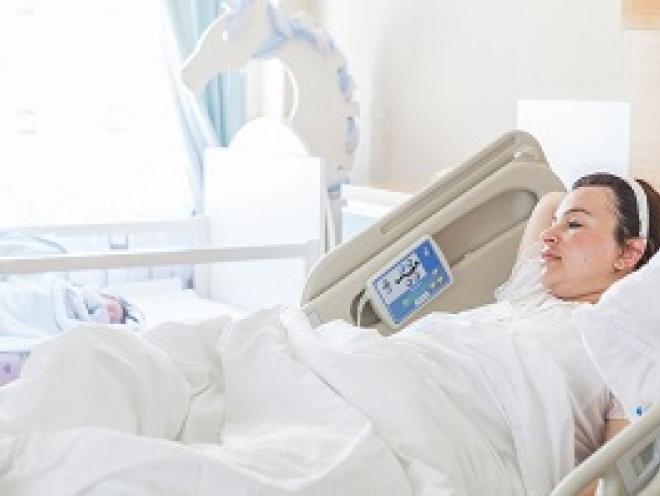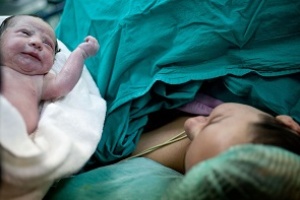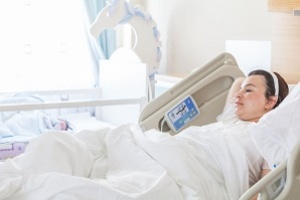Whether your caesarean birth was planned or not, you’ll need time to recover. We look at what to expect during recovery and when to seek medical advice.
After a caesarean birth, you may be in hospital for three to four days (NHS 2019a), although some people decide to go home earlier. Either way, you will need to take it easy for a few weeks to support your recovery. Here’s what you can expect.
What happens straight after a caesarean birth?
You and your baby will move from the operating theatre to a recovery room nearby, where a midwife will monitor you both for the next few hours. This will include monitoring your breathing, heart rate, blood pressure and your pain levels (NICE, 2021). You might experience nausea and trembling for a while.
During this time, you will be encouraged to have skin-to-skin contact with your baby (NICE, 2021). You may like to try to get them to latch, if you have decided you want to breastfeed. Your midwife can support you with this.
You can begin eating and drinking when you wish (NHS, 2019; NICE, 2021), and you’ll also be encouraged to move around when you feel able to get out of bed (NHS 2019).
If your baby needs to go to special care, your partner might have to decide between being with you or your baby. If they stay with the baby, they might be able to provide skin-to-skin contact during this time. Try to discuss in advance what you’d like to happen in this situation.
Breastfeeding after a caesarean
In most cases you will be able to start breastfeeding your baby as soon as you feel ready to. Sometimes establishing breastfeeding after giving birth by caesarean can be delayed because you may have been separated from your baby, or because you may lack mobility or be in pain (Beake et al, 2022; Sheedy et al 2022).
If you are choosing to breastfeed, you should be offered additional support to help you start as soon as possible (NICE, 2021). Research shows skin-to-skin contact and latching the baby on to the breast as soon as possible after birth will promote breastfeeding and is associated with positive mental health (Sheedy et al 2022).
This video shows different breastfeeding positions, including positions that work well after a caesarean.
Breastfeeding can sometimes be uncomfortable while you are recovering from a caesarean birth. Asking for the cannula to be inserted into the forearm rather than the back of the hand may allow more flexibility for latching your baby on.
Lying down to feed or using the “rugby ball” hold may also be more comfortable than the cradle hold, as it keeps the baby away from the caesarean wound. Take a look at our article on breastfeeding positions that might work for you.
Pain relief after a caesarean
It's common to experience pain for a few days or weeks following a caesarean, but it should lessen and stop over time.
In hospital you'll be offered pain relief. Your health care provider will discuss your options base on the severity of the pain, what anaesthetic was used during your caesarean, and whether you are breastfeeding.
You might be offered opioid pain relief that you can control yourself, through a drip, or you might be given tablets, such as ibuprofen, paracetamol, or morphine. To reduce the side effects of the opioid, you may be offered a laxative or stool softener, or an anti-sickness drug if you need it (NICE, 2021).
Once the initial post-operative pain relief has worn off, ibuprofen and/or paracetamol may be enough to manage the pain, but you may need something stronger. You can request this when you're in hospital or after being discharged (NICE, 2021).
If you're concerned about the level of pain you're experiencing, or your symptoms are getting worse, talk to your midwife or doctor as soon as you can (NICE, 2021). If you are in a lot of pain, it's less likely you'll be able to do other things that aid recovery, like eating healthy foods and moving around (NHS 2019b).
Avoid housework and don't drive, exercise, or have sex until you feel able to do so without pain (NHS 2018; NHS 2019). It's a good idea to avoid lifting anything heavier than the baby for a while afterwards.
If you aren't sure about anything, ask your midwife, health visitor or doctor.
Recovering on the postnatal ward
After spending time in the recovery room, you’ll be moved to a postnatal ward.
Your midwife will aim to remove your catheter (a tube into the bladder to collect urine) as soon as you are mobile to improve your ability to move and speed up recovery after the operation (NICE, 2021). You can shower, or if you don't feel up to it, you can opt for a bed bath (avoiding the surgical wound).
The wound dressing should be removed after 24 hours. Loose, comfortable clothing that sits well above the bikini line is often most comfortable and keeps the wound site clear of irritation (NHS, 2019).
You may need some help to pick up your baby for at least the first day.
If you’re recovering well and have no complications, you can eat and drink when you’re hungry or thirsty (NHS 2019). Constipation can be common after birth, so eat fibre-rich foods and drink plenty of water to prevent uncomfortable constipation. Chewing gum can encourage speedier bowel recovery after a caesarean birth, and may be especially helpful if you don’t feel like eating in the few hours after surgery (Pereira et al, 2016).
The average length of hospital stay after a caesarean is three to four days (NHS, 2019a). This is longer than the average stay for a vaginal birth, which is one to two days. But if you and your baby are recovering well, you could decide to go home.
Bleeding after caesarean birth
It’s completely normal to have some vaginal bleeding (lochia) for two to six weeks after you give birth, for both vaginal and caesarean births. If you feel worried about the amount of bleeding at any stage, or start to notice clots of blood, you should contact your midwife or doctor straight away (NHS, 2019; NHS 2021).
You can read our articles about bleeding after birth.
How do I care for the wound?
A waterproof dressing will be put over your wound to begin with. This dressing might be removed as soon as 6-24 hours after the birth (NICE, 2021). If you’re worried about the dressing or it needs changing, ask a midwife for advice.
Once the dressing has been removed, you'll need to keep the wound clean and dry while it heals (NHS, 2019; NICE, 2021). A week or so after the operation it might start to itch, which is good news – the wound is starting to heal. Most often the scar fades over time to a faint line barely visible and usually below the bikini line (NHS, 2019).
While the wound heals, you might find you feel more comfortable in loose clothing that sits high on the waist. Cotton underwear might also help (NHS, 2019).
If you notice the wound looking red and/or swollen and it feels painful, or a discharge, pus or any bad smelling fluid is coming from the wound, phone your local maternity assessment centre immediately (NHS, 2019).
Where dissolvable stitches have not been used, removable stitches or staples will be usually be taken out five days to a week after giving birth (NHS, 2019).
Some midwives and hospital trusts now recommend massage of a healed caesarean scar, though research into the benefits of this is limited. The suggestion is that scar tissue can attach to the skin and muscles around it, which can be painful, and massage can reduce these bands of scar tissue. Massage should only be started when the scar is fully healed – no scabs or open areas – and when you are comfortable enough to do it. See here for further information on massage for caesarean scars.
When can I go out and about with my baby?
In hospital and when you get home, you’ll be encouraged to move around to prevent deep vein thrombosis.
As you recover more, you can go out walking, though you might want to have someone with you at first because you shouldn’t lift anything heavier than your baby for the first few weeks (NHS, 2019). That means you will need help with lifting a pram or buggy up or down steps or lifting your baby in a car seat (NICE, 2021).
When can I have sex again?
You can resume sexual activity whenever you’re ready, though some advice suggests waiting until the postnatal bleeding has stopped before resuming penetrative sex.
Sex may be uncomfortable during recovery from pregnancy and birth – the caesarean scar may still be tender, and the vagina may be drier due to hormonal changes. Either or both partners may feel hesitant, so communication is important (NHS, 2018). Any concerns can be discussed with a GP at the six to eight week check.
Fertility can return from a few weeks after birth, so consider contraception if you don’t want to conceive another baby soon after giving birth (NHS, 2018).
Physical and emotional recovery
Physical recovery from caesarean birth can typically take around 6 weeks, but everyone is different, and you may need longer. Whatever happens, it’s important you take the time to rest and recover (NHS, 2019).
You might also find the recovery emotional as you process what’s happened. This applies to any type of birth. This can particularly be the case if you have had an unplanned caesarean birth. You’ll need to take care of yourself both physically and emotionally to recover well.
If things are tough, remember you're not alone. Consider talking to your birth partner, friends and family, a peer supporter, or your GP.
This page was last reviewed in April 2022.
Further information
Our support line offers practical and emotional support with feeding your baby and general enquiries for parents, members and volunteers: 0300 330 0700.
We also offer antenatal courses which are a great way to find out more about birth, labour and life with a new baby.
Make friends with other parents-to-be and new parents in your local area for support and friendship by seeing what NCT activities are happening nearby.
Find out more about recovering from a caesarean from NHS Choices.
Read the DVLA’s guidance about driving after an operation.
Beake S, Bick D, Narracott C, Chang Y. (2016) Interventions for women who have a caesarean birth to increase uptake and duration of breastfeeding: A systematic review available at: https://pubmed.ncbi.nlm.nih.gov/27882659/. [Accessed 26th April 2022]
NICE. (2021) Caesarean section. Available from: https://www.nice.org.uk/guidance/cg132/resources/caesarean-section-pdf-35109507009733 [Last accessed 26 April 2021].
NHS (2018) Sex and Contraception after birth. Available at: https://www.nhs.uk/conditions/baby/support-and-services/sex-and-contraception-after-birth/ [Accessed 26th April 2022]
NHS Choices. (2019a) Caesarean section: recovery. Available from: https://www.nhs.uk/conditions/caesarean-section/recovery/ [Last accessed 26 April 2022].
NHS Choices. (2021) Your body just after the birth. Available from: https://www.nhs.uk/conditions/pregnancy-and-baby/you-after-birth/#going-to-the-toilet [Last accessed 26 April 2022].
Pereira G, Riera R, Porfírio G, Macedo C, Sarmento Va, de Souza P, Torloni M. (2016) Does chewing gum after a caesarean section lead to quicker recovery of bowel function? Available at: https://www.cochrane.org/CD011562/PREG_does-chewing-gum-after-caesarean-section-lead-quicker-recovery-bowel-function [Accessed 26th April 2022]
Prior E, Santhakumaran S, Gale C, Philipps L, Modi N, Hyde M. (2010) Breastfeeding after cesarean delivery: a systematic review and meta-analysis of world literature. Available at: https://doi.org/10.3945/ajcn.111.030254 [Accessed 26th April 2022]
RCOG (2015) Reducing the Risk of
Venous Thromboembolism during Pregnancy and the Puerperium . Available at: https://www.rcog.org.uk/media/qejfhcaj/gtg-37a.pdf [Accessed 26th April 2022]
Sheedy G, Stulz V, Stevens J, (2022) Exploring outcomes for women and neonates having skin-to-skin contact during caesarean birth: A quasi-experimental design and qualitative study, Women and Birth. Available at: https://www.sciencedirect.com/science/article/abs/pii/S1871519222000117 [Accessed 26th April 2022]








